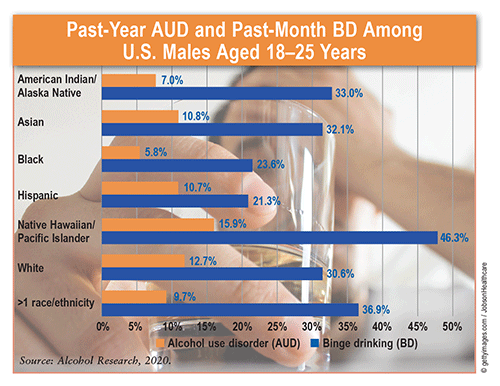US Pharm. 2023;48(6):14.
According to the latest National Survey on Drug Use and Health, there are >133 million current alcohol users aged >12 years in the United States. One in 10 of these individuals has alcohol use disorder (AUD), and almost one-half of current alcohol users have participated in binge drinking (BD) within the past month. More than 50% of Americans have also reported an increase in alcohol consumption since the COVID-19 lockdowns, which may have led to increases in other related health issues as well.

AUD: Most U.S. adults consume alcohol at least once in their lifetime, and nearly 7% will develop AUD (based on Diagnostic and Statistical Manual of Mental Disorders criteria). The National Center for Drug Abuse Statistics (NCDAS) estimates that of the 14.8 million Americans diagnosed with AUD, the majority are men (61.7%). Native Hawaiian/Pacific Islander, white, and Asian men have the highest incidences of past-year AUD (15.9%, 12.7%, and 10.8%, respectively). The number of Americans with AUD is increasing each year, as is the collective loss of potential life due to excessive drinking (an average of 3.6 million years of life annually).
BD: BD is defined as a pattern of drinking that increases the blood alcohol concentration to >0.08%. For men, this is the consumption of >5 alcoholic drinks on a single occasion (for women, >4 drinks). The CDC notes that BD is more common in men than in women (21% vs. 13%, respectively) and is reported most often among young adults aged 18 to 25 years. Native Hawaiian/Pacific Islander, multiple-race, and American Indian/Alaska Native men have the highest incidences of past-month BD (46.3%, 36.9%, and 33.0%, respectively). Trends suggest that the gap between men and women is narrowing; however, BD is increasing among men aged >65 years (12.8% to 15.7% from 2015 to 2019) while remaining stable among women aged >65 years (7.6% to 7.3% during the same period). An estimated 25% of men who binge drink do so >5 times per month, with 25% consuming >9 drinks on a single occasion.
Alcohol-Related Consequences: According to recent NCDAS data, >100,000 Americans die from alcohol-related consequences each year, with men being three times more likely than women to die from this cause. The World Health Organization has found that excessive alcohol use is responsible for 7.1% of the burden of disease in men, compared with a rate of 2.2% for women. Men may experience erectile dysfunction; infertility; increased aggression and violence; a higher risk of mouth, throat, esophageal, liver, colon, and prostate cancers; greater engagement in risky sexual activity; and more alcohol-related hospitalizations than women.
The content contained in this article is for informational purposes only. The content is not intended to be a substitute for professional advice. Reliance on any information provided in this article is solely at your own risk.
To comment on this article, contact rdavidson@uspharmacist.com.





